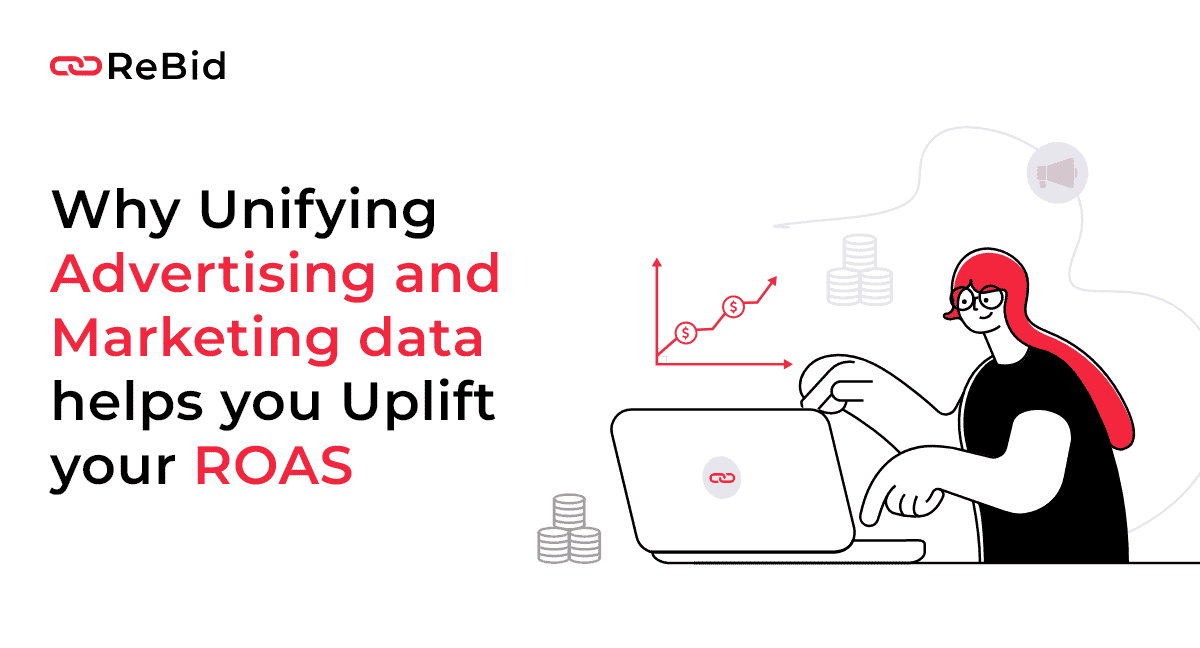Ad campaigns are the heart of every business, so much that businesses are willing to spend ample funds on them. According to a survey by emarketer in 2021, the cost of overall digital ad campaigns has reached a whopping $500 Billion!

Although marketers are ready to invest in advertising campaigns, they have to make every dollar spent to work for them. To achieve that, marketers need to focus on analyzing numbers, marketing strategies, and data to realize efficiency of marketing campaigns. ROAS is an essential tool to track ad costs and drive revenue for marketing campaigns.
Let’s dive into more about ROAS and how unifying advertising and marketing data can help uplift your ROAS.
ROAS and its importance for advertisers
ROAS is a widely known marketing metric, digital advertisers use to measure business profits garnered from every dollar markets spend on marketing their products and services. Very much like ROI, ROAS evaluates return on marketing costs beared for digital advertising. Apart from ROAS of the entire marketing allotment, you can also calculate it granularly based on specific ads, targeting, advertising campaign and many more.
- The main purpose of ROAS lies in identifying scaling opportunities by calculating which campaigns are top performing. With the addition of running multiple campaigns whilst you assess each of them, and capitalize on the campaigns along with the highest ROAS to boost your revenues.
- Cut unnecessary spending by calculating results that are insightful in aiding you to recognize the ad sets and campaigns on which you might be splurging. In such matters, you can curtail your budget to safeguard your business from losses.
- ROAS helps you to filter your advertising strategy, so that you can easily figure out which campaigns are better performing than the others, therefore you can coordinate your strategies based on these parameters to maximize future profits.
Why do Advertisers struggle to get good ROAS?
Many advertisers depend on a siloed approach to advertising, that is a brand acquires various vendors to attain different roles. These might comprise a data-sourcing solution to trail the purchase history of customers, a data management platform to congregate and analyze source data, a demand-side platform to ascertain and purchase advertising options, and a measurement solution to analyze fruition and aggregate insights for future initiatives. Advertisers might use a different vendor for each step of an ad campaign, and can even utilize multiple vendors at each step.
However, it is crucial to understand that not all vendors handle data the same way. For instance, it is not possible for all the data you receive from providers to navigate efficiently to your DMP or DSP when it’s time for you to execute your campaign. These cases of data leakage means that your insights become less and less accurate, and your audience pool will start to deplete. Having data stored in different silos just means that advertisers are unable to see the complete picture of their target audience or campaign performance, which continually leads to poor decision-making, missed opportunities and ad waste. If each vendor did bring such inconsistencies into the working, it means losing consumer targets and data, plus your potential to scale is at risk. It will end up with too much clutter and no order in advertising.

According to a survey, marketers find data siloed as the biggest hindrance when it comes to accurately track and measure ROAS.
Disrupting Data Silos: An Omni-Channel solution
To disrupt data silos, a unified engine which allows for data analysis in place of a siloed approach is preferred. Each separate unit of the engine is designed to work in unison and should allow you to connect with consumers with ad content in real-time.
That is why omnichannel advertising is the future of advertising. With the incorporation of omnichannel advertising, you can carry out advertising campaigns using all types of channels, platforms and devices to promote your products to customers. You create a seamless transition between various platforms: PPC, landing pages, social media, TV, “over the top” or OTT, direct mail, billboards, radio, blogs and all the other channels that can be deployed to engage the targeted demographic content path of consumers.
Omni-channel puts provides a coherent and consistent experience across all touchpoints. As an advertiser you can display objective oriented ads across various advertising channels depending on different points in the customer roadmap for better resonation. You can enhance various sections like customer loyalty, brand recall and repeat purchases are all by omni-channel strategy. Through content personalisation ads using omni-channel strategy, you can retain and attract new customers. The better the customer experience you provide, the more customers will convert.
According to reports, omni-channel personalization is known to have a 90% higher customer retention rate than the single channels. There are many benefits to this:
- Personalized omni-channel experiences are a great way to offer applicable items to customers at the right time. Likewise, companies make significant investment in personalization programs which have increased leading companies revenue by 6% to 10%.
- Make sure that your customer completes their purchase journey, while increasing average order value with tactics like targeted offers, automated product recommendations and many more. This is shown to influence 92% of customers to complete a purchase.
- Dynamic personalization provides a highly personalized experience that vibes with your audience and boost conversions.
- With an extensive omni-channel personalization strategy you can interact with any customer at all touchpoints providing a full suite of products through any preferred communication.
In summary, Omni-channel advertising helps in evaluating data and optimizing data across various platforms at a unified interface. You can unify data with three steps:
- Eliminate silos and consolidate customer data
- Measure and optimize the entire customer roadmap
- Create dynamic personalized customer experiences
CDPs are built for gathering, sorting, and distributing first-party data. CDPs are also good for ethically collecting first-party data, and staying within the legal line when it comes to collection of data. Boost your ROAS by creating highly personalized re-positioning campaigns based on your data.
Get started with us & improve your ROAS
The MadTech solution
MadTech combines the prime assets of marketing advertising and technology. It brings the collection of personalized, individual reach of MarTech with extensive data pools of AdTech. With the coming together of marketing technology and advertising technology, publishers come in a position where they can raise customers at every potential digital domain. With MarTech, companies can execute a unified, continuous and vastly personalized experience across all touchpoints. MarTech marketers are developing systems to automate customer engagement obtained from these kinds of insights. They enhance with unique experiences and hyper-personalization, at the right time in the right concept for every customer. Hence, MadTech is the best solution for saving time and increasing ROAS.
ReBid is a full stack MadTech automation solution connecting unknown to known customers. It is the world’s first unified Marketing and Advertising platform AI platform that leverages MadTech to drive ROAS for marketers and agencies.





